Kevin Lynn
Jul 17, 2025
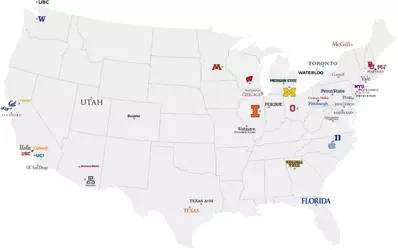
Top 50 Computer Science Universities in North America
Last week, our Substack focused on how the American engineering degree, sold as a solid ticket to the American dream, has become less solid for recent graduates trying to find that first job. This week, we took a look at job prospects for computer science graduates. If you thought prospects for engineering graduates were poor, even more recent American computer science graduates are scrambling for scraps, while a growing number of foreign workers on employment visas are being guaranteed jobs.
In 2023, American colleges graduated 134,153 citizens or green card holders with bachelor's or master's degrees in computer science. That same year, our federal government handed out work permits to at least 110,098 foreign workers in computer occupations through just three major guest worker programs. That's equal to 82% of our graduating class who are guaranteed jobs even before any Americans walk across the stage for their diploma.
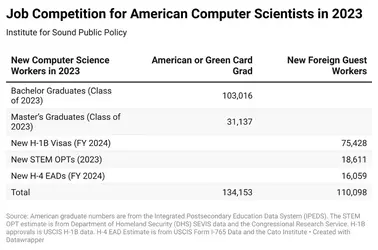
This isn't competition. This is systematic displacement, dressed up in the language of diversity and global talent acquisition. And it's destroying the future we promised our own students.
Let's start with the most obvious deception: the salary myth. Yes, computer science starting salaries have grown over the past decade, but the reality is far more sobering than the headlines suggest. Real wage growth has been virtually stagnant since 2015, increasing a measly $1,727 over eight years—a pathetic 1.8% bump that barely keeps pace with inflation.
The only significant salary increase occurred between 2014 and 2015, when starting salaries jumped $8,924 in a single year. Since then? Nothing. The market has spoken, and it's saying that American computer science graduates are worth exactly what they were nearly a decade ago.
Why? Because when you flood the labor market with foreign workers approved by the government for lower wages and worse working conditions, you don't get innovation—you get wage suppression. Every H-1B visa holder working for less than market value drives down compensation for everyone else. It's basic economics, and it's working exactly as Silicon Valley intended.
Let that sink in: Half of our computer programming graduates are not in full-time jobs within six months of graduation. In the supposed golden age of technology, when every company claims to be desperately seeking tech talent, half of our trained programmers still need work.
The unemployment rate among recent computer science majors sits at 6.1%—one of the highest among all surveyed majors. Meanwhile, 16.5% are stuck in jobs that don't require a college degree, according to U.S. Census data analyzed by the New York Federal Reserve. These aren't statistics; they're dreams deferred and futures destroyed.
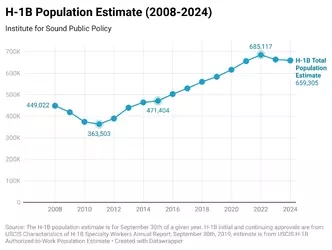
The H-1B visa program has exploded from 363,503 workers in 2011 to 685,117 in 2022—an 81% increase. Between 60% and 70% of these visas go to workers in computer occupations, directly taking entry-level positions from American graduates.
But H-1B is just the beginning. The STEM Optional Practical Training program allows international students to work for up to three years after graduation, with 30% of participants being computer science majors. Employers receive a 15% discount for every STEM OPT they hire because they don’t have to pay Social Security or Medicare taxes, while government labor protection or oversight is minimal. Meanwhile, the H-4 EAD program gives work permits to spouses of H-1B workers, who can work any job at any wage, with 63.75% working in computer science fields.
These aren't random policy decisions—they're deliberate choices to prioritize foreign workers over American students. We're literally training our own replacements and calling it progress.
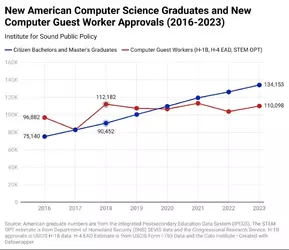
Think about that ratio: for every one American we educated in computer science, one foreign guest worker got a job in the same field. We spent billions of dollars through federal student aid, state university funding, and private investment to build the world's best computer science education system—then systematically undermined its graduates with a flood of foreign competition.
This isn't immigration policy; it's economic warfare against our own citizens.
If there's truly a shortage of qualified American workers, why are employment rates for new graduates in free fall? Why are starting salaries stagnant? Why are recent graduates taking jobs that don't require degrees?
The answer is simple: there is no shortage. There's only a desire for cheaper labor and more compliant workers. H-1B visa holders are tied to their employers and can be deported if they lose their jobs. They're less likely to demand raises, switch companies, or report workplace violations. They're the perfect workforce—if you're an employer looking to maximize profits at the expense of worker rights.
These are young Americans drowning in student debt, unable to find work in their chosen field, watching as their government actively works against their interests. They're not asking for handouts or special treatment—they're asking for a fair chance to compete in their own country.
We need to stop pretending that flooding the labor market with foreign workers is somehow beneficial to American students. It's not. It's a policy choice that benefits employers at the expense of workers, and it's time to admit that truth.
The data is clear, the problem is obvious, and the solution is within reach. The only question is whether we have the political will to put American workers first—or whether we'll continue to sacrifice another generation of computer science graduates on the altar of cheap labor.
Our students deserve better. Our country deserves better. And it's time we started acting like it.
P.S.
We are doing this data-based series because our youngest, best, and brightest should be protected from the harmful aspects of anti-American citizen policies that, in the long run, hurt the national interests. If you agree, become a paid subscriber or go to our donation page and send some dollars or bitcoin our way.
Here’s the link:
https://instituteforsoundpublicpolicy.org/donate/
https://www.cato.org/blog/facts-about-h-4-visas-spouses-h-1b-workers
Source (Archive)
Jul 17, 2025

Top 50 Computer Science Universities in North America
Last week, our Substack focused on how the American engineering degree, sold as a solid ticket to the American dream, has become less solid for recent graduates trying to find that first job. This week, we took a look at job prospects for computer science graduates. If you thought prospects for engineering graduates were poor, even more recent American computer science graduates are scrambling for scraps, while a growing number of foreign workers on employment visas are being guaranteed jobs.
In 2023, American colleges graduated 134,153 citizens or green card holders with bachelor's or master's degrees in computer science. That same year, our federal government handed out work permits to at least 110,098 foreign workers in computer occupations through just three major guest worker programs. That's equal to 82% of our graduating class who are guaranteed jobs even before any Americans walk across the stage for their diploma.

This isn't competition. This is systematic displacement, dressed up in the language of diversity and global talent acquisition. And it's destroying the future we promised our own students.
The Salary Mirage
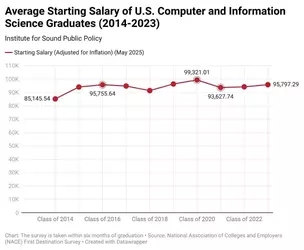
Let's start with the most obvious deception: the salary myth. Yes, computer science starting salaries have grown over the past decade, but the reality is far more sobering than the headlines suggest. Real wage growth has been virtually stagnant since 2015, increasing a measly $1,727 over eight years—a pathetic 1.8% bump that barely keeps pace with inflation.
The only significant salary increase occurred between 2014 and 2015, when starting salaries jumped $8,924 in a single year. Since then? Nothing. The market has spoken, and it's saying that American computer science graduates are worth exactly what they were nearly a decade ago.
Why? Because when you flood the labor market with foreign workers approved by the government for lower wages and worse working conditions, you don't get innovation—you get wage suppression. Every H-1B visa holder working for less than market value drives down compensation for everyone else. It's basic economics, and it's working exactly as Silicon Valley intended.
The Employment Catastrophe
While salaries stagnated, employment prospects for new graduates have cratered. The percentage of computer science graduates employed full-time within six months of graduation has plummeted from 73.2% in 2014 to just 64.3% in 2023. For those who specialized in computer programming, the situation is even worse—employment rates have collapsed from 69% to 50% in the same period.Let that sink in: Half of our computer programming graduates are not in full-time jobs within six months of graduation. In the supposed golden age of technology, when every company claims to be desperately seeking tech talent, half of our trained programmers still need work.
The unemployment rate among recent computer science majors sits at 6.1%—one of the highest among all surveyed majors. Meanwhile, 16.5% are stuck in jobs that don't require a college degree, according to U.S. Census data analyzed by the New York Federal Reserve. These aren't statistics; they're dreams deferred and futures destroyed.

The H-1B visa program has exploded from 363,503 workers in 2011 to 685,117 in 2022—an 81% increase. Between 60% and 70% of these visas go to workers in computer occupations, directly taking entry-level positions from American graduates.
But H-1B is just the beginning. The STEM Optional Practical Training program allows international students to work for up to three years after graduation, with 30% of participants being computer science majors. Employers receive a 15% discount for every STEM OPT they hire because they don’t have to pay Social Security or Medicare taxes, while government labor protection or oversight is minimal. Meanwhile, the H-4 EAD program gives work permits to spouses of H-1B workers, who can work any job at any wage, with 63.75% working in computer science fields.
These aren't random policy decisions—they're deliberate choices to prioritize foreign workers over American students. We're literally training our own replacements and calling it progress.
The Decade of Displacement
The scope of this problem becomes clear when you zoom out to 2016 through 2023. During this period, the United States graduated 838,279 American citizens with computer science bachelor's and master's degrees. Simultaneously, the government, at the behest of employers, imported or granted 833,132 foreign computer workers with guaranteed jobs through just three guest worker programs.
Think about that ratio: for every one American we educated in computer science, one foreign guest worker got a job in the same field. We spent billions of dollars through federal student aid, state university funding, and private investment to build the world's best computer science education system—then systematically undermined its graduates with a flood of foreign competition.
This isn't immigration policy; it's economic warfare against our own citizens.
The Mythology of Necessity
Defenders of this system will tell you that we need foreign workers because Americans can't fill these roles. They'll point to skills gaps and talent shortages, conveniently ignoring the fact that we're graduating more computer science students than ever before.If there's truly a shortage of qualified American workers, why are employment rates for new graduates in free fall? Why are starting salaries stagnant? Why are recent graduates taking jobs that don't require degrees?
The answer is simple: there is no shortage. There's only a desire for cheaper labor and more compliant workers. H-1B visa holders are tied to their employers and can be deported if they lose their jobs. They're less likely to demand raises, switch companies, or report workplace violations. They're the perfect workforce—if you're an employer looking to maximize profits at the expense of worker rights.
The Real Tragedy
Behind every statistic is a human story. These are American students who did everything right—they studied hard, earned competitive degrees, and entered a field they were told would guarantee their success. Instead, they're competing against foreign workers who are often willing to work for less because their alternative is deportation.These are young Americans drowning in student debt, unable to find work in their chosen field, watching as their government actively works against their interests. They're not asking for handouts or special treatment—they're asking for a fair chance to compete in their own country.
The Path Forward
The solution isn't complicated, but it requires political courage that has been in short supply. We need to dramatically reduce the H-1B visa program, eliminate the STEM OPT extension, and end work permits for H-1B spouses. We need to prioritize American workers in American jobs funded by American taxpayers.We need to stop pretending that flooding the labor market with foreign workers is somehow beneficial to American students. It's not. It's a policy choice that benefits employers at the expense of workers, and it's time to admit that truth.
The data is clear, the problem is obvious, and the solution is within reach. The only question is whether we have the political will to put American workers first—or whether we'll continue to sacrifice another generation of computer science graduates on the altar of cheap labor.
Our students deserve better. Our country deserves better. And it's time we started acting like it.
P.S.
We are doing this data-based series because our youngest, best, and brightest should be protected from the harmful aspects of anti-American citizen policies that, in the long run, hurt the national interests. If you agree, become a paid subscriber or go to our donation page and send some dollars or bitcoin our way.
Here’s the link:
https://instituteforsoundpublicpolicy.org/donate/
Data Sources
Computer Science Starting Salary Data
https://www.naceweb.org/job-market/graduate-outcomes/first-destination/American Computer Science Graduates Data
https://nces.ed.gov/ipedsH-1B Data
https://www.uscis.gov/sites/default/files/document/reports/ola_signed_h1b_characteristics_congressional_report_FY24.pdfSTEM OPT Work Permit Data
https://www.ice.gov/doclib/sevis/btn/25_0605_2024-sevis-btn.pdfSTEM OPT Computer Science Major Data
https://www.congress.gov/crs-product/IF12631H-4 EAD Data
https://view.officeapps.live.com/op/view.aspx?src=https%3A%2F%2Fwww.uscis.gov%2Fsites%2Fdefault%2Ffiles%2Fdocument%2Fdata%2Fi765_application_for_employment_fy24.xlsx&wdOrigin=BROWSELINKhttps://www.cato.org/blog/facts-about-h-4-visas-spouses-h-1b-workers
Source (Archive)
